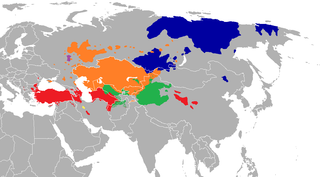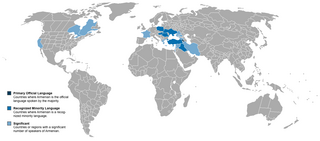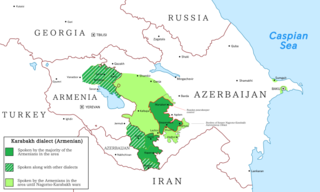The vast majority of loanwords from the Turkic languages in the Armenian language are geographically located close to Turkic-speaking regions. [1] This concerns, first of all, the Istanbul Armenian dialect of the language in which most of borrowings from Turkish language. [2]

The Turkic languages are a language family of at least thirty-five documented languages, spoken by the Turkic peoples of Eurasia from Eastern Europe, the Caucasus, Central Asia, and West Asia all the way to North Asia and East Asia. The Turkic languages originated in a region of East Asia spanning Western China to Mongolia, where Proto-Turkic is thought to have been spoken, according to one estimate, around 2,500 years ago, from where they expanded to Central Asia and farther west during the first millennium.

The Armenian language is an Indo-European language spoken primarily by Armenians. It is the official language of Armenia. Historically being spoken throughout the Armenian Highlands, today, Armenian is widely spoken throughout the Armenian diaspora. Armenian is written in its own writing system, the Armenian alphabet, introduced in 405 AD by Mesrop Mashtots.

Istanbul, formerly known as Byzantium and Constantinople, is the most populous city in Turkey and the country's economic, cultural and historic center. Istanbul is a transcontinental city in Eurasia, straddling the Bosporus strait between the Sea of Marmara and the Black Sea. Its commercial and historical center lies on the European side and about a third of its population lives in suburbs on the Asian side of the Bosporus. With a total population of around 15 million residents in its metropolitan area, Istanbul is one of the world's most populous cities, ranking as the world's fourth largest city proper and the largest European city. The city is the administrative center of the Istanbul Metropolitan Municipality. Istanbul is viewed as a bridge between the East and West.
However, the influence of the Turkic languages spread not primarily a literary language, and mainly on the dialects.[ clarification needed ] Therefore, Turkic loanwords are only to a negligible extent preserved in the literary language. In general, according to Hrachia Acharian, both versions of literary Armenian language contain very little Turkic loanwords. [1] The language of the Ashiks was full of dialect, as well as Turkic and Iranian loanwords. [3]

An Ashik was traditionally a singer who accompanied his song— be it a dastan or a shorter original composition—with a long necked lute (bağlama) in Turkish culture and related Turkic cultures. The modern Azerbaijani ashik is a professional musician who usually serves an apprenticeship, masters playing the bağlama, and builds up a varied but individual repertoire of Turkic folk songs. The word ashiq عاشق is subjective forms derives from ishq عشق (love), related to Avestan iš- "to wish, desire, search". The Turkish term that ashik superseded was ozan. In the early armies of the Turks, as far back as that of Attila, the ruler was invariably accompanied by an ozan. The heroic poems, which they recited to the accompaniment of the kopuz, flattered the sensibilities of an entire people.
Some Turkic loanwords became international words, found in other languages as well as Armenian and Turkic. [1]








